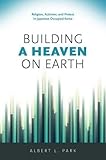Building a Heaven on Earth : Religion, Activism, and Protest in Japanese Occupied Korea / Albert L. Park.
Material type: TextPublisher: Honolulu : University of Hawaii Press, [2014]Copyright date: ©2014Description: 1 online resource (320 p.)Content type:
TextPublisher: Honolulu : University of Hawaii Press, [2014]Copyright date: ©2014Description: 1 online resource (320 p.)Content type: - 9780824839659
- 9780824853273
- 261.80951909041 23
- online - DeGruyter
- Issued also in print.
| Item type | Current library | Call number | URL | Status | Notes | Barcode | |
|---|---|---|---|---|---|---|---|
 eBook
eBook
|
Biblioteca "Angelicum" Pont. Univ. S.Tommaso d'Aquino Nuvola online | online - DeGruyter (Browse shelf(Opens below)) | Online access | Not for loan (Accesso limitato) | Accesso per gli utenti autorizzati / Access for authorized users | (dgr)9780824853273 |
Frontmatter -- Contents -- Acknowledgments -- Introduction -- Part I: Religion, Revolt, and Reimagining a Modern Korea, 1860- 1937 -- Chapter 1. Origins of Protestantism and Tonghak in Late Chosŏn Korea -- Chapter 2. Economic and Social Change under Japanese Colonialism -- Chapter 3. A Heavenly Kingdom on Earth: Th e Rise of Religious Social Ideology -- Part II: Building a Heaven on Earth, 1925- 1937 -- Chapter 4. The Path to the Sacred: Korea as an Agrarian Paradise -- Chapter 5. Spiritualizing the National Body: Sacred Labor, Community, and the Danish Cooperative System -- Chapter 6. Constructing National Consciousness: Educating and Disciplining Peasants' Minds -- Conclusion -- Notes -- Bibliography -- Index
restricted access online access with authorization star
http://purl.org/coar/access_right/c_16ec
Why and how did Korean religious groups respond to growing rural poverty, social dislocation, and the corrosion of culture caused by forces of modernization under strict Japanese colonial rule (1910-1945)? Questions about religion's relationship and response to capitalism, industrialization, urbanization, and secularization lie at the heart of understanding the intersection between colonialism, religion, and modernity in Korea. Yet, getting answers to these questions has been a challenge because of narrow historical investigations that fail to study religious processes in relation to political, economic, social, and cultural developments. In Building a Heaven on Earth, Albert L. Park studies the progressive drives by religious groups to contest standard conceptions of modernity and forge a heavenly kingdom on the Korean peninsula to relieve people from fierce ruptures in their everyday lives. The results of his study will reconfigure the debates on colonial modernity, the origins of faith-based social activism in Korea, and the role of religion in a modern world. Building a Heaven on Earth, in particular, presents a compelling story about the determination of the Young Men's Christian Association (YMCA), the Presbyterian Church, and the Ch'ŏndogyo to carry out large-scale rural movements to form a paradise on earth anchored in religion, agriculture, and a pastoral life. It is a transnational story of leaders from these three groups leaning on ideas and systems from countries, such as Denmark, France, Japan, and the United States, to help them reform political, economic, social, and cultural structures in colonial Korea. This book shows that these religious institutions provided discursive and material frameworks that allowed for an alternative form of modernity that featured new forms of agency, social organization, and the nation. In so doing, Building a Heaven on Earth repositions our understandings of modern Korean history.
Issued also in print.
Mode of access: Internet via World Wide Web.
In English.
Description based on online resource; title from PDF title page (publisher's Web site, viewed 02. Mrz 2022)


